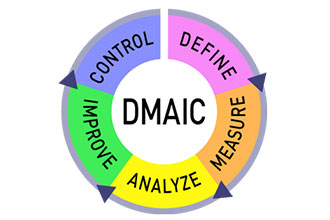The Sales Process: Improve It or Lose It
 In my most recent blog, I discussed how the lack of empowerment can cripple a sales team and how the root cause could be higher up in the chain of command than you may actually think. I also mentioned how the fix to this type of problem and many other organizational issues can be found by using the Six Sigma DMAIC methods for continuous improvement. This week I will go into a bit more detail about the DMAIC methods and give an overview of Six Sigma. DMAIC stands for Define, Measure, Analyze, Improve and Control. As I write this I am already realizing that this is going to take a few blogs to cover, so consider this part one of a multi-part blog. Today, I will talk about where Six Sigma and the DMAIC method fit into sales and in the coming weeks I will go into detail about the DMAIC method.
In my most recent blog, I discussed how the lack of empowerment can cripple a sales team and how the root cause could be higher up in the chain of command than you may actually think. I also mentioned how the fix to this type of problem and many other organizational issues can be found by using the Six Sigma DMAIC methods for continuous improvement. This week I will go into a bit more detail about the DMAIC methods and give an overview of Six Sigma. DMAIC stands for Define, Measure, Analyze, Improve and Control. As I write this I am already realizing that this is going to take a few blogs to cover, so consider this part one of a multi-part blog. Today, I will talk about where Six Sigma and the DMAIC method fit into sales and in the coming weeks I will go into detail about the DMAIC method.
If you have never heard of Six Sigma that probably makes this blog a bit easier to read, but if you have heard of it, I will need you to let go of any possible preconceptions you may have and give what I am saying a chance. The reason I say it may be easier to accept Six Sigma if you’ve never heard of it is because how Six Sigma was thought of five to ten years back. Back then Six Sigma was often being used by a lot of organizations to justify a process re-engineering effort that was crafted by executive management and other boards to appease shareholders. Way too often, these were implemented incorrectly and used as “house cleaning” projects to justify layoffs. There was a lot of promoting of Six Sigma in the manufacturing world and it started to be known solely for manufacturing defect improvement through process improvement. The two biggest misconceptions about Six Sigma and the DMAIC method are that it is just for manufacturing and that it is a way to reduce your staffing requirements (fire people). As you read on, I will try to show you that Six Sigma is much more than a manufacturing line improvement project. It can go the core of just about every organization and increasing productivity with existing resources — not getting rid of them.
What is Six Sigma? Six Sigma is about continuous process improvement. The name Six Sigma comes from the calculations that show us how close we are to meeting our customer’s requirements (the only real measurement that matters). When we meet our customer’s requirements 100 percent, we have zero deviation from our goal. Since Sigma is the Greek symbol for a Standard Deviation we use Sigma to describe how close we are to meeting our customer’s goals. The more Sigma, the closer we are to perfection. Six Sigma indicates we have met our goals with 99.99966 percent accuracy. Six Sigma also equates to 3.4 defect per 1 million product produced. That is pretty close to perfection. So, is our goal in sales perfection? Sure, why not? We can strive for perfection, even if we know it can’t be achieved. Try being Catholic and you will know what I am talking about. I am going to get some heat for that one, but I am leaving it in. When Jack Welch introduced Six Sigma to GE he stated, “We are going to shift the paradigm from fixing products to fixing and developing processes, so we are producing nothing but perfection or close to it.” When I look at a quote from one of the best business minds of our time, I learn that there is nothing wrong with having that lofty of a goal.
I started this blog about sales, so the question remains, what does Six Sigma have to do with sales? I believe the act of sales is a process with a product. When I talk about what a sales person produces I am not referring to the widget that they are pedaling, but rather the sales process itself — a sales person produces customer service. Six Sigma is perfect for service organizations. If you ask me, sales (customer service) is definitely a process that can be measured and improved.
As I stated before, Six Sigma is about process improvement and sales is a process. Six Sigma is about improving speed, quality and complexity. Speed, quality and complexity are paramount to sales success (and the success of just about every other service related business) and therefore the process of sales (and other service businesses) is a prime example of a process that Six Sigma is perfect for.
As we look at what the Six Sigma DMAIC method will bring us, I feel I need to first tell you what Six Sigma and Process Improvement IS and IS NOT. Refer to the table below to see what is and is not Six Sigma Process Improvement:
| Six Sigma Process Improvement for Sales | ||
| IS | IS NOT | |
| CRM | A system to deploy TOOLS to make sales people more effective and that removes barriers from their sales paths. | A tracking tool to determine whether your sales people are as busy as you want them to be. |
| Sales Reporting | A system or process that reduces tasks and activities that hinder a sales person’s direct work in selling. Any activity that is not directly related to sales needs to be removed. | A system that forces sales people to become report generators rather than sales generators. |
| Processes and Checklist | Process and systems that make sales people more effective by giving them tools to stay focused on the task of SALES. | Adding processes to account for sales people productivity regardless of the added burden the system will have on sales people. |
| Activity and opportunity tracking are not substitutes for supporting SALES. The needs of the system should NEVER outweigh the needs of the sales team. | ||
What I am trying to say is that a CRM system is not a substitute for good processes and process improvement is not a substitute for developing your sales force. If you are considering process improvement and deploying a CRM system or if you are re-examining your process and CRM deployment, you need to make sure that the processes and systems support the sales team and not the other way around. I remember working for a VERY large company and one of the people I respect in this industry said, “If a sales person wants to submit a P.O. on a bar napkin, then we need to have a system that supports that.” At that time I was a gung-ho analytically driven IT type that was a stickler for the process and the confines of CRM system. I learned then that the needs of the sales team far outweigh the needs of us sales support people (if you are not in sales, then you support sales). The first and most important aspect of a CRM (sales reporting and data mining system) is that it supports the needs of the sales team. I have seen too many times where a CRM system is implemented so that upper management had “visibility” and middle management has “accountability.” If your system’s goals are visibility and accountability then your system might be missing the most important aspect — usability.
Next week I will go into the details of the Define and Measure aspects of the DMAIC methods for process improvement.





